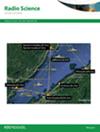A prototype of a 900 MHz band integrated rectenna by using a planar monopole antenna with feeder
IF 1.6
4区 地球科学
Q3 ASTRONOMY & ASTROPHYSICS
引用次数: 0
Abstract
a rectenna designed for wireless power transfer at 900 MHz focuses on conjugate impedance matching and image impedance matching for improved efficiency. To do them, a voltage doubler rectifier circuit (VD) and a planar monopole antenna (PMA) were engineered with the same pure resistance value and integrated into the rectenna. The input impedance of the VD with 30 Ω load resistance indicated a pure resistance of approximately 73 Ω. This value closely matches the input impedance of a dipole antenna operating as a pure resistor. Since the prototype rectifier circuit is unbalanced, the authors constructed a PMA, an unbalanced antenna similar to a dipole antenna, on a double-sided circuit board. In this setup, a microstrip line was created by extending the radiating element, achieving the impedance matchings. Measurements indicated a voltage standing wave ratio of approximately 1.03. A rectenna efficiency of 37.4% was observed for a transmission distance of 50 cm. The rectification efficiency of the VD is nearly 0% when the input power is less than — 20 dBm, and the received power of the PMA is less than — 20 dBm when the transmission distance is 60 cm or more. It is predicted that the rectenna efficiency will be 0% when the transmission distance is 60 cm or more. However, the rectenna efficiency was 24.6% when the transmission distance was 60 cm. This over 20% improvement is due to the connection between the PMA and the VD using pure resistance.使用带馈线的平面单极子天线的 900 MHz 波段集成整流天线原型
一种为 900 MHz 无线功率传输而设计的整流天线侧重于共轭阻抗匹配和图像阻抗匹配,以提高效率。为此,设计了一个电压倍增器整流电路(VD)和一个平面单极天线(PMA),它们具有相同的纯电阻值,并集成到整流天线中。负载电阻为 30 Ω 的电压倍增器的输入阻抗显示,纯电阻值约为 73 Ω。由于原型整流电路是不平衡的,因此作者在双面电路板上构建了一个 PMA(一种与偶极子天线类似的不平衡天线)。在这个装置中,通过延长辐射元件创建了一条微带线,从而实现了阻抗匹配。测量结果表明,电压驻波比约为 1.03。在传输距离为 50 厘米时,整流天线效率为 37.4%。当输入功率小于 - 20 dBm 时,VD 的整流效率接近 0%;当传输距离大于等于 60 厘米时,PMA 的接收功率小于 - 20 dBm。据预测,当传输距离为 60 厘米或以上时,整流天线效率将为 0%。然而,当传输距离为 60 厘米时,整流天线效率为 24.6%。之所以能提高 20% 以上,是因为 PMA 与 VD 之间的连接使用了纯电阻。
本文章由计算机程序翻译,如有差异,请以英文原文为准。
求助全文
约1分钟内获得全文
求助全文
来源期刊

Radio Science
工程技术-地球化学与地球物理
CiteScore
3.30
自引率
12.50%
发文量
112
审稿时长
1 months
期刊介绍:
Radio Science (RDS) publishes original scientific contributions on radio-frequency electromagnetic-propagation and its applications. Contributions covering measurement, modelling, prediction and forecasting techniques pertinent to fields and waves - including antennas, signals and systems, the terrestrial and space environment and radio propagation problems in radio astronomy - are welcome. Contributions may address propagation through, interaction with, and remote sensing of structures, geophysical media, plasmas, and materials, as well as the application of radio frequency electromagnetic techniques to remote sensing of the Earth and other bodies in the solar system.
 求助内容:
求助内容: 应助结果提醒方式:
应助结果提醒方式:


